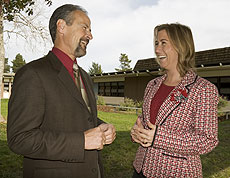February 20, 2006
Professor helps assess health of teacher workforce
By Jennifer McNulty
School districts in Santa Cruz, Monterey, and San Benito Counties are lucky to have assistant professor of education Lora Bartlett on their team.

Lora Bartlett with Dan Cope, assistant superintendent with the Santa Cruz County Office of Education
Photo: Jim MacKenzie |
Bartlett specializes in teacher workforce issues, and she is applying her expertise locally, where about one-third of teachers are nearing retirement age and the cost of living forces many new teachers to leave the area.
Those factors may be beyond the control of school administrators, but they make it even more important for districts to ensure that working conditions contribute to high levels of job satisfaction so that teachers who can afford to live in the region will stay in town.
That's where Bartlett comes in. She is chair of the research committee of the Teacher Workforce Initiative (TWI), a three-year collaborative effort to take the pulse of teachers in the tricounty area. The Center for the Future of Teaching and Learning, a Santa Cruz-based nonprofit, has teamed up with the Monterey Bay Educational Consortium to gather detailed demographic information from local teachers to assess the strength of the workforce. The consortium is made up of representatives of schools and local colleges and universities.
"It's about making sure enough teachers are in the pipeline," said Dan Cope, assistant superintendent with the Santa Cruz County Office of Education. "We're making sure teachers aren't leaving our area for reasons we could do something about."
Although school districts are required by law to provide the state with annual data regarding teachers, they lack the resources to analyze the data in a timely way, said Cope, who calls Bartlett's participation on the project "fortuitous."
"She fits in perfectly because of her background and training," said Cope. "She's just brilliant with research and information."
Bartlett, who joined the project last year, is building a web site where the data will be available for immediate analysis. She is also expanding the data-collection effort to include fine-grained information about salaries, benefits, school-based working conditions, and teacher turnover rates, which affect the quality of classroom instruction and student achievement.
Last year, a preliminary analysis of 10 school districts in the region found that 250 teachers left their jobs. This year, all departing teachers will be asked to fill out an exit questionnaire, and a subset will be interviewed to gather more-detailed information.
Cope is optimistic that the results of the project, now in its final year, will reveal opportunities for improvement. For example, if less-experienced teachers are concentrated in certain schools, it may make sense to bring in some veteran teachers to support the novices, said Cope.
"We want our decisions to be data-driven rather than hit-and-miss," he said. "Districts attempt to use data, but it's usually about student achievement. We haven't focused on teacher employment data. It has really opened our eyes."
Meanwhile, members of the Monterey Bay Educational Consortium will identify points of action. For example, Cal State Monterey Bay has already bolstered the math and special education elements of its teacher-preparation program to address regional needs.
 Email this story
Email this story
 Printer-friendly version
Printer-friendly version
 Return to Front Page
Return to Front Page